The answer to all these questions is RETROFIT
Retrofit refers to any improvement work on an existing home to improve its energy efficiency, making it easier to heat, able to retain that heat for longer, and replacing fossil fuels with renewable energy.


I want to - keep warmer and cooler
-
Minimise heat loss
-
Deal with damp
-
Heat people not homes
- Efficient heating
-
Efficient heating:
-
Using foil panels as insulation behind radiators that are in front of uninsulated external walls can reduce heat lost. This means you’ll spend less money heating the radiator up, and it’ll stay hotter for longer.
-
Has your boiler been serviced regularly? If a boiler isn’t maintained, it can become less efficient, and a build-up of sludge can make it harder for the boiler to heat the whole house.
-
When was the last time you bled your radiators? This ensures there is no trapped air in the system leading to cold spots.
-
For more information follow these links:
Energy Saving Trust - Warm Home Hacks guide
CSE - How to stay warm for less
Ask for help:
Call 0800 038 5722 Warm and Safe Wiltshire provide in-depth telephone support and home visits to help people save money on their gas and electricity bills, and to get funding for heating and insulation improvements in their homes. warmandsafewiltshire.org.uk
and more on the Resources page
COOLER IN SUMMER
The word 'coolth' has the opposite meaning of 'warmth,' referring to the condition of having a moderately low temperature – that is the condition of being cool.
20% of our homes overheat in the summer. The solutions to this are insulation, ventilation, window shading and addressing 'cold bridges' which become 'thermal bridges' in the summer.
-
Minimise heat loss: You can keep warmer by ensuring that your home retains as much heat as possible. So tackle draughts and maximise your home's insulation. see draughtproofing and insulation
-
Deal with any damp areas. Damp walls lose heat 30% faster than dry ones. see Damp or Mould
-
Heat people not homes : Wear warm clothes, only heat rooms in use and consider electric blankets or bed warmers.


I want to - save money on my energy bills
You can save money by ensuring every penny is spent usefully:
Looking at the energy bill for a typical UK home: 62% is spent on heating, 18% on water heating and 14% on appliances.
HEATING
-
Don’t waste any heat
-
Reduce draughts
-
Address any damp or condensation areas
-
Improve insulation: roof, walls, floor : see insulation
-
Turn thermostats down, use smart controls
OTHER APPLIANCES:
-
Invest in the most energy efficient appliances that you can afford
-
Maintenance: de-ice fridges/freezers and keep air vents clear
-
Plan cooking: use microwaves and slow cookers rather than ovens. Batch cook and freeze meals
-
Lighting : use LED energy efficient bulbs
-
Avoid stand-by modes
-
Use an energy meter to assess the usage of your appliances
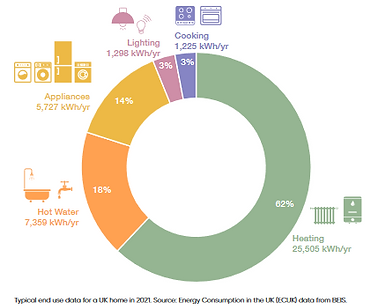
SUPPLIER TARIFFS :
-
make sure you are on the best rate and you taking advantage of any support available www.moneysavingexpert.com
-
Warm and Safe Wiltshire provide in-depth telephone support and home visits to help people save money on their gas and electricity bills, and to get funding for heating and insulation improvements in their homes. warmandsafewiltshire.org.uk or Call 0800 038 5722
-
Saving money and energy in your home OneHome-Money_saving_guide.pdf

Embodied carbon represents the carbon emissions released during the lifecycle of building materials, including extraction, manufacturing, transport, construction, and disposal. Concrete, steel, and some insulation are all examples of materials that contribute significantly to embodied carbon emissions.
Some insulating materials like straw bale, hempcrete, and wool will store (sequester) carbon and have negative emissions over their lifetime, while others like extruded polystyrene (XPS) are made with blowing agents that have high global warming potentials (GWP).
Compared with rigid insulation and spray foams, blown-in fibreglass and cellulose insulation have much lower carbon impacts.
Step 2. Move from fossil fuel use to clean electricity :
-
Buy your electricity from a supplier using, and investing in, green energy. If you are planning to put in solar panels, look at what their latest deals are. You can find explanations and up to date reports on Which and Money Saving Expert.
-
Produce your own renewable energy from solar or wind power
-
Use Solar energy to heat your water directly
-
Install an efficient electric boiler such as an air source heat pump
Very Important - solar panels and heat pumps do not produce infinite amounts of energy and you should do Step 1 first to avoid the risk of high electric bills or insufficient heating.

How can you get towards Net Carbon Zero?
Step 1
-
a) Reduce your home energy use by making your home as energy efficient as possible (operational carbon) : Retrofit to as deep a level as you can (the ideal is the EnerPHit Standard)
-
b) Be mindful of embodied carbon when choosing materials.
Currently, “The UK has the worst housing stock in Europe – leaky, damp and badly insulated” (CSE) so a significant proportion of the energy used to power our homes is wasted. This also leads to fuel poverty and poor health due to cold, damp homes with poor air quality and a high carbon footprint.
What is the best possible? The EnerPHit certificate (Passivhaus Trust) allows renovation of older properties to the highest standards, giving existing buildings the ability to approach net zero and meet the predicted capacity of a decarbonised grid. We need to create comfortable, liveable homes that are resilient to climate change and will withstand future weather events.
A Net Zero carbon home in operation is very energy efficient and has an ultra-low level of space heating demand. It does not use any fossil fuels on site and therefore improves air quality. It also generates renewable energy on-site and is cheap to run.

I want to - help save the planet
In the UK, domestic home energy use produces 16% of the carbon dioxide and other greenhouse gases in this country. To achieve the necessary target of Net Zero by 2050 we have to transfer to renewable electricity to power our homes and stop using oil, gas and coal.
You are not alone There are many local and regional community groups who are working together on sustainable projects to insulate homes and install renewable energy : check out our resources page
Keen to get started? go to Make a Plan click here...

I want to - deal with Damp and Mould
Damp walls are cold walls. They lose heat 30% faster than dry ones, leading to cold rooms, increasing heating costs and may give rise to mould formation with the associated health impacts such as asthma, eczema and depression.
Condensation tends to be the most common problem; this arises when moisture, produced in the home from washing, cooking, and breathing, condenses to become water on contact with cold surfaces. Over time, this creates an environment for black mould to grow. You usually find this on walls or windows and may be associated with cold bridges.
‘Penetrating' damp is moisture entering the house through leaking pipes, a damaged roof, blocked gutters, gaps around window frames and cracked rendering and brickwork etc. All these problems can be remedied. Check around your house for areas of damp or damage. Checklist.pdf
‘Rising' damp is due to a defective or non-existent damp course. This will leave a ‘tide mark’ about 1m above the floor. Fixing rising damp is a job for a qualified builder.
*Draught proofing and insulating your home will increase its airtightness. This can trap moisture in your home, so it is vital that damp areas are treated and condensation prevented, by reducing the amount of moisture you produce, having fans in place and insulating the walls.
For more information
CSE Advice Leaflet - Damp and Mould
and the Resources Section

Make a Plan
SO RETROFITTING YOUR HOME IS A 'WIN-WIN': it will ensure that you are warm and comfortable, save money and you are looking after the planet.
Does your home have an EPC?
-
The Energy Performance Certificate shows the current and potential energy efficiency rating of your home from A (most efficient) to G (least efficient). It also lists ways you can improve the rating along with indicative costs.
-
Aim for C or better -
-
D or worse could make you eligible for grants for insulation,
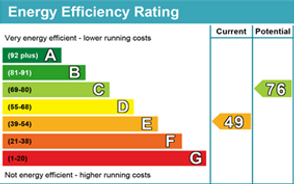
All homes are unique in construction, position and state of repair. Improving your home is likely to be a fairly complex project involving investment (grants), disruption and several different stages.
1. Make a preliminary assessment of your home
-
Assess your home for areas that need repair like poorly fitting windows, draughts around doors, areas of condensation or damp. How much insulation is in the loft? Are your windows double glazed? Do you have cavity wall insulation and if so when was it installed? Maintenance Check-list.pdf
-
Look at your energy costs : electricity, gas, oil, coal etc and calculate your annual expenditure.
-
Have a thermal image survey done of your home.
a) borrow a thermal camera
b) a knowledgable volunteer can conduct your survey
c) have a professional survey - this is advised before any major works - Futureproof, Sustainable Lifestyles
This can identify draughts and cold spots, but remember to maintain correct ventilation to avoid damp areas
What are the measures that might be taken? click here for In a Nutshell
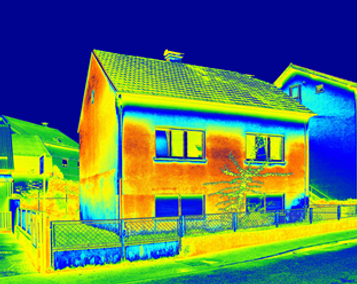
2. Have an in-depth assessment carried out :
Ideally engage a qualified retrofit assessor eg FutureProof
They can carry out a survey looking at your home from floor to roof so as to identify how you can make your home warmer and less wasteful. They will provide a bespoke retrofit report with recommendations on the most cost-effective and impactful home retrofit measures for your home. This can be a significant investment, although grants may be available. Understanding the whole picture means that you can plan the retrofit according to your circumstances, before you start.

DISCOUNT: September 2024 - Futureproof are currently offering discounted surveys in Wiltshire click here for details
or Plan your own project
Please do lots of research : there is a lot of information in our Resources section.
-
Centre for Sustainable Energy Low-carbon retrofitting: a whole-house approach is a really good start
-
Devon Retrofit Guide This free guide is for people who want to carry out their home improvements themselves. It explains the retrofitting process providing you with valuable insights, tips, and practical advice to help you embark on your journey. It describes the four most common housing types in Devon offering detailed guidance on how to upgrade these buildings.
-
The Net Zero Carbon Toolkit. An excellent 90-page introduction to decarbonising your home funded by the Local Government Association. This covers choice of heating methods, insulation, ventilation, windows,project management, planning etc. for new build and retrofit (including to listed homes)
-
Historic England. Older houses (built before 1920) provide different challenges. This helpful website provides lots of practical advice to homeowners and occupiers on maintaining, repairing and improving historic buildings to increase energy efficiency and resilience to flooding.
Meet other homeowners through Green Open Homes.
Green Open Homes events are an opportunity to ask a neighbour about an energy saving improvement that they’ve made, and see if it might work for you. On an event day, people who have made energy saving improvements open up their homes to share their experiences. Their website has lots of case histories from past events.
Exciting News: Wiltshire is having it's next Green Open Homes event on 9th to 17th November 2024
Resources : There are helpful websites, community groups, webinars, videos and phone in advice lines. You can take courses online or in person. Take a look at our Resources section
Steps
-
Use renewable energy technologies to reduce emissions further.
-
Implement “low hanging fruit” measures that are low cost and easy to install, e.g. energy efficient lighting, basic heating controls, better control settings.
-
Bring the building fabric into good repair, by dealing with defects that inhibit energy efficiency and compromise improvement measures such as water penetration, damp, structural defects and poor pointing in masonry, window and door draughts.
-
Improve the building fabric by means of insulation and air-tightness measures, and by minimising thermal bridging, in order to reduce heat losses and demand
-
Satisfy the remaining heat demand as efficiently as possible using efficient heating technology and responsive controls

“It is important to understand the link between insulation, airtightness, breathability and ventilation. Otherwise you will store up problems for the future.”
“If you insulate without air-tightness you will be disappointed. Insulation won’t stop the draughts so you will still feel chilly. If you insulate and get airtight, but don’t ventilate, the air will feel stale and you’ll invite condensation and, maybe, mould. If you live in an old house, leaving breathability out of the equation will also promote condensation and mould.” Beginner’s Guide to Eco-Renovation, Judith Leary-Joyce, AoEC Press 2022
Draught-proofing
-
A smoke pencil is a good investment here - be a draught detective!
-
Chimneys : block off your chimney with a chimney balloon or Chimney Sheep®
-
Windows and doors : fill gaps around the frame with caulk. Use door sausages and door curtains.
-
Put plastic window film over frames.
-
Use draught-proofing adhesive strips around frames of windows, doors and loft hatches to provide a tight seal.
-
Tip - it is also important to think about the gaps between the door frame and the wall, the window frame and the wall or even around the loft hatch and the ceiling joists

Insulation
-
Roof :
-
The recommended thickness of roof insulation has increased considerably over the years. Even if you already have some insulation, your loft may need a top-up.
-
The recommended depth for mineral wool insulation – the most common material – is 270mm (about 1ft), but there are other materials (such as natural wool or wood fibre) which require different depths
-
-
Walls:
-
Cavity walls: it is worth having a wall survey as many old cavity infills have deteriorated or slumped. The old material could be suctioned out and replaced with more efficient material.
-
Solid walls
-
Additional insulation may be internal or external. A full retrofit survey should be carried out first, as professional advice is needed to choose the best solution for your home.
-
-
Floors:
-
In general, improving floor insulation is the job of a professional builder. However, carpet underlay and rugs will be helpful
CSE Advice leaflet - Floor insulation -
NB also consider the Embodied carbon
-
-
Windows and Doors:
-
Secondary glazing can be a cost-effective way of reducing this heat loss and making your home more comfortable.
-
a) Thin transparent plastic film which you install yourself using strips of double-sided sticky tape around the frame of the window and shrunk taut using a hair dryer.
-
b) to fit a sheet of rigid and transparent materials like clear acrylic plastic or clear polystyrene to the window frame in such a way that it can be put up or taken down as the season requires
CSE Advice leaflet - secondary glazing
-
-
Double/Treble Glazed Windows and High Thermal Performance Doors:
-
Installing energy efficient glazing and high thermal performance doors will reduce heat loss, to keep your home warmer and cut heating bills. Glazing can also insulate against external noise.
-
Thermal bridging
A thermal bridge is an area in a building where a break occurs in the insulation (for example: the roof/wall junction and the wall/floor junction). These areas transmit more heat than the surrounding building fabric, reducing your property’s thermal energy efficiency. They can create cold spots, which increases the risk of condensation forming. In summer they will cause heat to be brought into the house.
Bridges can be formed by metal that passes through the insulation e.g. pipes, fixings, frames, or recessed lights and floor joists.
These will be identified during a thermal survey.

Ventilation matters
Part of the goal of heat retention is to improve air tightness to avoid draughts and leaks, it is important to allow the building to “breathe,” or poor air quality, condensation and damp problems may result. As fresh air will no longer be provided by natural draughts, it is necessary to ventilate your home with fresh air, using extractor fans or consider installing a ventilation system. You may want to get specialist advice. "draughts are uncontrolled and potentially dangerous, while ventilation is controlled or planned and vital for our health”
MVHR Mechanical Ventilation Heat Recovery systems extract warm, damp air from the home and draw in fresh air from the outside.
The warm, extracted air is passed through a heat exchanger to recover the heat before being expelled outside.
The cool, fresh outside air is then passed through the heat exchanger, where it is pre-warmed before being pumped into the property.
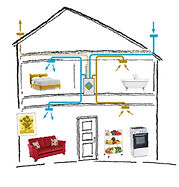

Insulation and Draught-proofing
Keep the Heat in!
Heat Pumps
Heat pumps are an economical and low-carbon space heating option for well-insulated homes.
Heat pumps
Heat pumps are at least three times more efficient than fossil fuel boilers because they draw warmth from the air, a body of water, or the ground. They only need to use a small amount of electricity on top of one of these natural sources of heat.
CSE Advice - Heat-pumps
Air source heat pumps take the warmth from the air outside (even when it’s freezing) and use it to heat the home.
CSE Advice leaflet - Different types of heat pumps
Ground source heat pumps take their heat from a coil buried in the ground. CSE Advice leaflet - Different types of heat pumps
Air-Air heat pumps work like reverse air conditioning and can heat individual rooms in winter and cool them in summer. (not available under Boiler Upgrade Scheme.) These are cheaper and quicker to install and but still need some other means to heat your water.
Energy Saving Trust - air to air heat pumps
Green Great Bedwyn air to air heat pumps pdf
To power itself, the heat pump uses electricity. But because the heat pump has taken some heat from the air, every unit (kilowatt hour or kWh) of electricity you put in will provide more than 1 usable unit of heat energy out (average 2.8kWh)
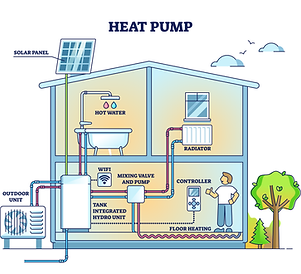
Heat pumps work most efficiently in well-insulated buildings, places that once they reach a comfortable temperature, stay warm and don’t lose their heat. Heat pumps also require properties to have a hot water cylinder.
Heat pumps are the inevitable successor to gas boilers in the UK, and the government is backing them with the Boiler Upgrade Scheme
Solar (PV) Panels
They're essential for an eco home – not only do they typically cut your electricity bills by 64%, but they also power other green products like heat pumps and electric vehicle chargers.
Solar panels turn sunlight into electricity through the ‘solar cells’ they contain. Electricity leaves the panel as direct current (DC) and passes through an inverter that converts it to 240V alternating current (AC) that can be used in your home.

When your solar panels are generating, the electricity will be used in any appliances that are switched on at the time, such as a washing machine, TV etc. Any surplus electricity in a typical setup will then be exported to the electricity grid or stored in a battery.
You can be paid for the energy that you export through ‘Smart Export Guarantee’ tariffs with energy suppliers and payments vary between suppliers. If you want to store this excess energy to be used later, there is additional equipment that can be used to store this as hot water in a hot water cylinder, or as electricity through using a domestic battery.
CSE Advice leaflet - a complete guide to solar PV
CSE Advice leaflet - Getting the best from your solar panel
What about a power cut?
During a power cut or planned outage, most solar panel systems will automatically switch off to protect engineers working on the lines. However, your installer can fit a system (relay switch) that automatically isolates your system from the grid, so that it can continue to function using your battery.
EcoExperts Advice leaflet - power cuts.pdf
Solar and Batteries
Store the excess electricity you generate at home. Domestic batteries are typically used alongside solar photovoltaic (PV) panels. But it can also be used to store cheap, off-peak electricity from the grid, which can then be used during peak hours (16.00 to 20.00).
If you have solar PV you can generate plenty of electricity when the sun is shining. But on overcast days you’ll make less, and you’ll make none at all at night. This generally doesn’t match up with when you want to use electricity; it’s at night when you want the lights on and to use appliances like a dishwasher or TV.
The electricity you generate, but don’t use, is typically exported into the national grid and used elsewhere – it’s not wasted. You can get paid for this, but the payment is much lower than the price you pay for electricity, so it’s better financially to use as much as possible in the home.
Tips on choosing a Solar PV supplier
Get at least 3 quotes to compare prices, systems, service and support.
Here is a simple quote comparison spreadsheet, that you can fill in as you go - link
Ensure your supplier is MCS registered mcscertified.com/
MCS also provide the GoRenewable Service gorenewable.org.uk/
Check the Centre for Sustainable Energy (CSE) advice sheet -
cse.org.uk/advice/a-complete-guide-to-solar-pv/
Solar Sherpa solar-sherpa.co.uk/ - information and supplier recommendations
Suppliers registered with the Solar Stewardship Campaign who look to ensure a holistic sustainable supply chain.

Solar Energy
Let's use the Sun's power - it's free!
Solar water heating or ‘solar thermal’, involves using solar panels to absorb the heat of the sun and transfer it to the water you use in the home.
On warm summer days a solar thermal system could provide all of your hot water. During the winter the output will be considerably less
Most solar water systems are ‘indirect’ – that is, the liquid in the roof panels is a mixture of water and antifreeze, and the heat it absorbs from the sun is transferred to the water in the hot water cylinder by way of a copper coil.
It is a sustainable solution, requiring 2 -5 msq of roof surface, ideally south facing and unshaded. You will also need a hot water storage cylinder

1. HUGS : Home Upgrade Grant in England
If you're off the main gas grid, on low income and have an energy performance certificate (EPC) rating from D to G, you might be eligible for a home upgrade grant (HUG).
This could include energy-efficiency measures such as wall, loft and underfloor insulation, installation of heat pumps, solar panels, double glazing, low energy lighting and electric storage heaters.
GOV.UK HUGS application
2. Government's Energy Company Obligation (ECO) scheme
Requires most energy suppliers to offer measures that help low income, fuel-poor and vulnerable households to heat their homes.
OFGEM Advice Leaflet - ECO for homeowners and tenants
3. The Great British Insulation Scheme (previously known as the ECO+ scheme)
To be eligible, the following needs to apply:
-
a) You own your home which is in council tax band A to D (A to E in Scotland),
-
Your home must have an EPC rating of D or below. OR
-
b) be in receipt of certain benefits.
Under the Great British Insulation scheme, those in the 'a) group' will only be able to get one type of insulation installed. For example, you could get cavity wall insulation OR loft insulation, but not both.
And you MAY have to pay a proportion of the costs, but you'll be told this before any work is approved. So it is important to have a plan before you apply for the funding.
4. Boiler Upgrade Scheme
£7,500 may be available, provided your area is off the gas network and your home has an EPC of D or better. You will need to completely scrap your old solid fuel or oil boiler.
GOV.UK - Boiler Upgrade Scheme
5. Wiltshire Council Funding
6. Local Community Schemes
7. Connected for Warmth is an award-winning grant scheme offering FREE energy-saving measures to homes across Britain, that can help you reduce your energy use and stay warm and well.
8. Green Mortgage or loan for improvements
Sounds great, but at the moment: Money Saving Expert Sept 23 “A growing number of mainstream lenders are now offering so-called green mortgages. The idea is that if you're moving into an energy-efficient home or making your property greener, your lender will reward you for that with a better interest rate or cashback on your mortgage. But we've found that 'green mortgages' aren't normally the cheapest home loan option.”

I want to: find Grants and Advice
-
Boilers
-
Insulation
-
Lighting
-
Heat Pumps
-
Advice
-
Electric heating
WHO CAN I ASK FOR ADVICE?
Warm and Safe Wiltshire
We provide in-depth telephone support and home visits to help people save money on their gas and electricity bills, and to get funding for heating and insulation improvements in their homes.
Financial assistance
Help with bills
Heating and Insulation grants and loans
warmandsafewiltshire.org.uk
Money saving expert
Resources
Helpful National Websites
Centre for Sustainable Energy The charity supporting people and organisations across the UK to tackle the climate emergency and end the suffering caused by cold homes CSE website
One of CSE’s key roles is to help local households understand their energy use, improve the energy performance of their homes, and develop more sustainable behaviours. They have a comprehensive range of information resources related to sustainable household energy; many links are provided within the pages. They work with Warm and Safe Wiltshire and Future Proof.
Energy Saving Trust They have a range of online resources related to making your home more energy efficient, reducing your carbon emissions and lowering your energy bills. EST Website
One Home Lots of resources in the Your Home website, including heating, lighting, energy tariffs and renewable energy. Transform your home and your garden into elegant and environmentally friendly spaces for you and your loved ones. One Home website
Historic England Older houses (built before 1920) present different challenges. This helpful website provides lots of practical advice to homeowners and occupiers on maintaining, repairing and improving historic buildings to increase energy efficiency and resilience to flooding.
Passivhaus retrofit guide Passivhaus is a tried and tested solution that gives us a range of proven approaches to deliver net-zero-ready new and existing buildings optimised for a decarbonised grid and augmented for occupant health and wellbeing. Passivhaus buildings provide a high level of occupant comfort using very little energy for heating and cooling. Highest standards to aim for also case studies, videos and staging. Passivhaus Trust website
National Self Build and Renovation Centre (NSBRC), Swindon: a full scale demonstration renovation house, over 200 supplier stands including many with low carbon products. Also run free monthly evening webinars and 1-2 day workshops on PassivHaus and making your house eco-friendly. NSBRC website
GreenSpec is the foremost ‘Green Building’ resource in the UK. Independent of companies and trade bodies and launched in 2003 with government funding, GreenSpec promotes sustainable building products, materials and construction techniques. GreenSpec website
Lendology - council funded lending for home improvements - Lendology website
Planning Your Project
Devon Retrofit Guide This free guide is for people who want to carry out their home improvements themselves. It explains the retrofitting process providing you with valuable insights, tips, and practical advice to help you embark on your journey. It describes the four most common housing types in Devon offering detailed guidance on how to upgrade these buildings. Retrofit Guide
The Net Zero Carbon Toolkit. An excellent 90-page introduction to decarbonising your home funded by the Local Government Association. This covers choice of heating methods, insulation, ventilation, windows,project management, planning etc. for new build and retrofit (including to listed homes):
Sustainable Traditional Buildings Alliance – STBA Promoting a whole house approach to retrofit of traditional buildings. SBTA website
Of particular interest, if a little complex, is the step by step guide through PAS 2035 standards specific to your house using their Guidance wheel SBTA Guidance wheel
Wiltshire Council energy costs and advice website
Bath and NE Somerset Council provides detailed useful information on different retrofitting options and how these can relate to different house types.
BANES Sustainable planning document
Frome Town Council Healthy Homes Webinar series, great CSE videos on explaining retrofit and insulation etc Frome Council Retrofit
The Carbon Smart Materials Palette Beautiful great information on insulation materials and embodied carbon.
The Eco Experts a blog post on the costs and returns of converting the average UK home into an eco-home Blog click here
How the average home can go green
A chance to look around a retrofitted home
Green Open Homes
A Green Open Homes event is an opportunity to ask a neighbour about an energy saving improvement that they’ve made, and see if it might work for you. On an event day, people who have made energy saving improvements open up their homes to share their experiences. Their website has lots of case histories from past events.
Case Studies
Take a look at our shared experiences page where there are real-life examples of people who have already undertaken these projects - click here
Heat pump advice
VISTA Visit a heat pump service
We are Nesta, the UK’s innovation agency for social good. We design, test and scale solutions to society’s biggest problems. We will soon launch a new service to help people learn first hand what it’s like to own a heat pump, from the people who know best. Register your interest to visit or host a heat pump open home: click here
Active Local Retrofit Groups
These groups are already very active in helping their community to improve their homes.
including:
Bradford on Avon Climate Friendly Bradford on Avon website
Calne Sustainable Calne website
Chippenham Zero Chippenham website
Great Bedwyn The Great Green Bedwyn website
Hungerford the HEAT website includes 10 fascinating retrofit case studies and other relevant material. website
Who can I ask for Advice?
Warm and Safe Wiltshire
We provide in-depth telephone support and home visits to help people save money on their gas and electricity bills, and to get funding for heating and insulation improvements in their homes. Financial assistance, help with bills heating and insulation grants and loans. website
And further afield:
Carbon Co-op is an energy services and advocacy co-operative that helps people and communities to make the radical reductions in home carbon emissions necessary to avoid runaway climate change. Based near Manchester they offer a monthly online Eco Lab Q&A and an active on-line community group. website
Birmingham The Civic Square is working to share practically and openly how the climate transition and retrofit of our homes and streets can be designed, owned and governed by the people who live there now in systemic, tangible and participatory ways. website
Cosy Homes Oxfordshire A great county scheme with useful webinars on retrofit. Resources such as plan builder only available to local homeowners. website
The National Retrofit Hub (the Hub) is a non-profit collaborative organisation working with the industry to enable the delivery of housing retrofit across the UK. It was set up in summer 2023 with the intention of developing a centralised resource of information and training. Sign up for their newsletter! website
Find a professional
General advice on choosing a supplier:
Check if your supplier and installer is registered with the relevant trade body, eg. Cavity Insulation Guarantee Agency , Solid Wall Insulation Guarantee Agency, Microgeneration Certification Scheme (for heat pump and Solar PV installations) or Trustmark.
Check if the products they supply are included in lists from PassivHaus, MCS etc. and try to locate and talk with a recent client for a similar project or installation.
TrustMark is the only government-endorsed quality scheme for work carried out in domestic properties. It is a requirement of the PAS standards that retro-fitted energy efficiency measures be fitted by a Trustmark-accredited installer. website
Futureproof FutureProof
National Insulation Association website
Renewable Energy Consumer Code RECC sets out high consumer protection standards for businesses who are selling or leasing renewable energy generation systems to domestic consumers. They have a specific section of their website which gives advice to consumers about buying small-scale renewable generation in the home, including a Consumer Guide, a Top Tips for Buyers and a short video. website
Microgeneration Certification Scheme Service Company They have a section for consumers detailing the renewable energy technologies available to heat and power homes. They also have a help desk that can answer questions on low carbon technology, help you find an MCS certified installer and provide support with installation. website
The Green Register of Construction Professionals : website not many in Wiltshire
The Eco Experts a blog post on the costs and returns of converting the average UK home into an eco-home Blog
Action Net Zero - How the average home can go green website
Useful Books:
Beginner's Guide to Eco Renovation: Understand the Basics and the Best Questions to Ask, Judith Leary-Joyce, AoEC Press 2022
Draughtproofing and Insulation, Tony Cowling, Crowood Press 2023







